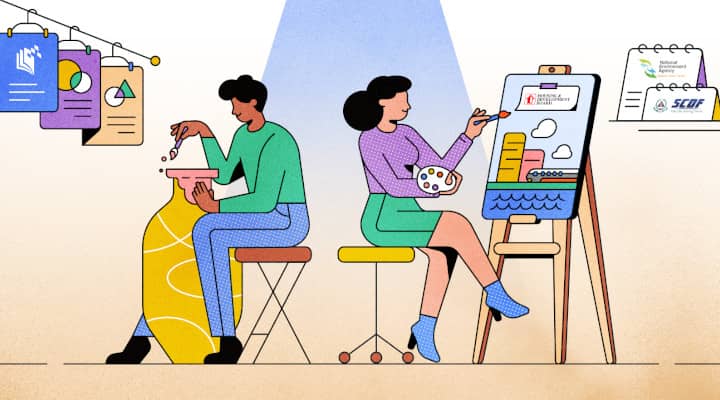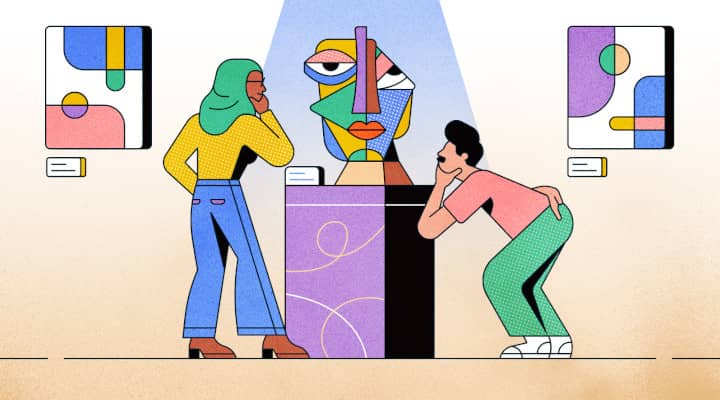Why Anyone Can Be Creative

When we think of work that requires creativity, we tend to picture more artistic roles such as graphic design or songwriting. Many public officers might not intuitively think that their jobs fall within this category.
The truth is, certain responsibilities we have at work involve creativity. Problem-solving, for example, requires creativity to generate innovative solutions to complex problems. Sometimes this means exploring new or unconventional ideas.
Here are some common myths about creativity and what you can do to exercise your creative muscles:
Creativity Across the Public Service
In the Public Service, creativity takes many different forms. Read these past Challenge stories on public officers whose creativity helped them at work:
- The librarian who designed an exhibition about the future using scenes from old movies
- The landscape architect who found creative ways to improve green spaces at HDBs
- The firefighters who reinvented firetrucks after being inspired by the movie Transformers
- The National Environment Agency team who innovatively used technology to clean up Singapore
Myth #1: Only Right-brained People Can Be Creative
We tend to think of people who seem more naturally creative as “right-brained”. The rest of us may consider ourselves “left-brained” – being naturally more logical and analytical.
In fact, creativity does not come from one half of the brain, neuroscientist Heather Berlin explains in the Netflix documentary series The Mind, Explained. It emerges when different sections of the brain “talk” to each other. This means that your ability to be creative is not restricted by your personality or thinking style.
Tip: No matter your personality type, try dabbling in different fields to expose yourself to different types of thinking and hone your creative problem-solving skills. Take a LEARN course in an unfamiliar subject or sign up for a TAP opportunity to learn outside your agency.
Myth #2: Creativity Is About Originality
In his book The Myths of Creativity, innovation expert David Burkus describes the Originality Myth as the belief that new ideas are unique, original and belong to one person or organisation.
But creativity is really about combining old ideas in new and interesting ways. Many famous creators, from William Shakespeare to Steve Jobs, borrowed heavily from existing works or built on their past ideas.
For public officers, new ideas are sometimes inspired by their hobbies, movies they watch or even jokes they exchange with colleagues.
Tip: Find ways to disrupt your patterns to make new connections. When brainstorming, for example, try using out-of-the-box prompts, different brainstorming methods or considering the problem from other perspectives.

Myth #3: Inspiration Strikes Randomly
When brainstorming for a new solution or idea, we may sit for hours, waiting for the moment the lightbulb goes off in our heads.
Burkus explains in his book that, sometimes, new ideas do suddenly appear, but we can also work to trigger them. This stage of the creative process is called incubation: setting aside the project or problem, and doing something else. While this happens, our subconscious combines knowledge and ideas from the work we have already done.
Tip: While some focus on other projects, others prefer taking a physical break from the work. . And yes, that includes sleeping.
Myth #4: Great Ideas Come From One Person
We tend to attribute ground-breaking ideas and creations to a single maverick, such as Albert Einstein or Pablo Picasso. However, more often than not, these geniuses did not make their achievements in isolation. Einstein, for example, spent years working at a patent office, which allowed him to incubate ideas and build on the work of others.
Beyond teamwork, brainstorming as a group works too – but only in the sharing and evaluation stages. Studies show that generating ideas as a group produces fewer and weaker ideas as compared to brainstorming alone.
Tip: To get the most out of your group brainstorming session, come up with ideas individually first. Then share and build on each idea, one person at a time. While exploring other subjects can be useful, try not to stray too far from the topic at hand.
Myth #5: Complete Creative Freedom Is Always a Good Thing
Being able to create with zero restrictions, infinite resources and no deadlines may sound ideal. But faced with so many choices and possibilities, we may not be able to come to a decision.
In fact, constraints can help to boost creativity by letting us focus our efforts on a more narrowly defined path. Restrictions that are beyond our control – such as deadlines and budgets – may actually be blessings in disguise.
Tip: You can also impose your own restrictions to spur your creativity. Try creating an elevator pitch for an idea in five minutes. You can also use prompts (e.g., designing for a specific demographic) or think of a scenario to generate ideas (e.g., a solution you would create if you only had half of your current resources).

To get more stories like this, subscribe to the Challenge newsletter or follow the Challenge Telegram channel.
- POSTED ON
May 26, 2022
- TEXT BY
Hidayah Md Sham
- ILLUSTRATION BY
Liew Xinyi








